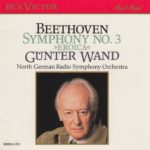
First of all, today is 9/11. So, on this day, especially during the morning hours, I always reflect on the attack in New York.
I remember watching the TV coverage live as it happened. I was in the meeting room of the ad agency where I worked at the time. All of us were. We gathered together and watched the planes hit, the towers fall.
And a ghastly silence fell over the room.
I remember feeling sick to my stomach.
I was in a daze the rest of the day, numb.
Apparently, so was everyone else. Hardly any cars were on the road. No planes were allowed to take off and land, so even the skies fell silent.
I will never forget that morning, or the days immediately after it.
 Okay. Now back to our regularly scheduled program: German conductor Gunter Wand (1912-2002), the North German Radio Symphony Orchestra, and Beethoven’s Symphony No. 3 in E flat Major.
Okay. Now back to our regularly scheduled program: German conductor Gunter Wand (1912-2002), the North German Radio Symphony Orchestra, and Beethoven’s Symphony No. 3 in E flat Major.
I first encountered Maestro Wand on Day 17. He received a “Huzzah!” rating from me.
Then, I listened to him on Day 35. He received another “Huzzah!” rating.
What will today’s listening bring?
From the liner notes translated by Gregg Beasley,
It was the unusually long development of the first movement which overtaxed the audience in Beethoven’s day.
But surely it is precisely this bold creative expansion, with its ever-new perspectives on the thematic material, which harbingers future developments of the symphonic form.
I’ve noticed the long first movement, evident in Wand’s interpretation most of all. Under Wand’s wand – er, baton – Movement I is a full 18 minutes in length. No other movement comes close.
Will that “unusually long development” mean sudden boredom? Will this recording hold my attention?
 Beethoven wrote his symphonies in four parts (except for the Sixth, which is in five). The time breakdown of this particular one (Symphony No. 3 in E flat Major), from this particular conductor (Wand, at age 73) and this particular orchestra (North German Radio Symphony Orchestra), at this particular time in history (1985) on this particular record label (RCA Victor Red Seal, now owned by Sony) is as follows:
Beethoven wrote his symphonies in four parts (except for the Sixth, which is in five). The time breakdown of this particular one (Symphony No. 3 in E flat Major), from this particular conductor (Wand, at age 73) and this particular orchestra (North German Radio Symphony Orchestra), at this particular time in history (1985) on this particular record label (RCA Victor Red Seal, now owned by Sony) is as follows:
I. Allegro con brio………………………………………………………………………18:00
II. Marcia funebre: Adagio assai……………………………………………….14:38
III. Scherzo: Allegro vivace – Trio…………………………………………………5:44
IV. Finale: Allegro molto – Poco andante – Presto…………………..11:30
Total running time: 50:03
My Rating:
Recording quality: 4 (a bit of top end missing, but hardly any tape hiss or ambient sounds)
Overall musicianship: 5
CD liner notes: 4 (a booklet in each CD jewel case; the essays on Symphonies 2 and 4 are brief but informative. In addition, the bulk of the text is in German, although the essays are also translated into English and French )
How does this make me feel: 5
“Huzzah!”
There’s something reverent about how this was recorded. It sounds lush, very symphony-like. It’s big, full, and energetic when it needs to be, and subdued when it needs to be.
This sounds like something I’d hear on the local Classical music station, WBLU-FM, which is operated by Blue Lake Fine Arts Camp Public Radio.
The aforementioned long first movement seems to speed along because it’s just so damn interesting and well played. And, while I’m at it, well recorded.
The Scherzo (Movement III) is especially lively under Wand’s baton. It’s as bouncy and fun as a puppy out for a walk. As I’ve mentioned before, I love the sound of a French horn. And this movement has lots of interplay between the French horns and the other instruments.
I don’t know what it is about Gunter Wand. Or the North German Radio Symphony Orchestra. Or both together. This is first-rate stuff.
Highly recommended.
